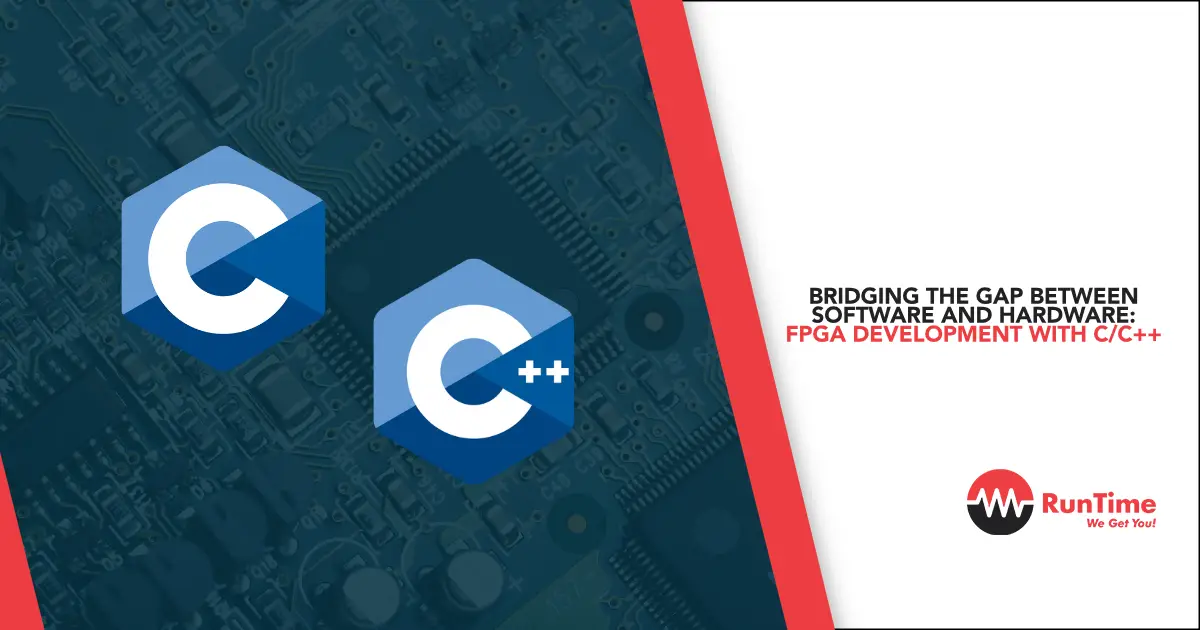Introduction
Field-Programmable Gate Arrays (FPGAs) have become a cornerstone of modern embedded systems, offering unparalleled flexibility and performance for a wide range of applications. From signal processing and machine learning to real-time control and high-speed data acquisition, FPGAs enable engineers to implement custom hardware solutions tailored to specific needs. However, traditional FPGA development has often been the domain of hardware engineers, requiring expertise in Hardware Description Languages (HDLs) such as VHDL or Verilog.
In recent years, there has been a growing trend towards bridging the gap between software and hardware by using high-level programming languages like C and C++ for FPGA development. This approach allows software engineers to leverage their existing skills and tools to design and implement FPGA-based solutions, accelerating development cycles and expanding the pool of talent capable of working with FPGAs.
This article explores the key concepts, tools, and best practices for FPGA development with C/C++, providing embedded engineers with a comprehensive guide to harnessing the power of FPGAs using familiar programming paradigms. By understanding and applying these techniques, engineers can unlock new possibilities in embedded system design and create innovative, high-performance solutions.
Understanding FPGA Development with C/C++
What is FPGA Development with C/C++?
FPGA development with C/C++ involves using high-level programming languages to design and implement hardware logic on FPGAs. Instead of writing low-level HDL code, engineers can use C/C++ to describe the desired functionality, which is then synthesized into hardware by specialized tools. This approach abstracts many of the complexities of hardware design, making FPGA development more accessible to software engineers.
Key Benefits of FPGA Development with C/C++
- Familiarity and Productivity: Software engineers can leverage their existing knowledge of C/C++, reducing the learning curve and accelerating development cycles. High-level abstractions and libraries further enhance productivity.
- Reusability and Modularity: C/C++ code can be more modular and reusable compared to HDL code, enabling engineers to create libraries and components that can be easily adapted for different projects.
- Rapid Prototyping: High-level synthesis (HLS) tools allow for rapid prototyping and iteration, enabling engineers to quickly explore different design options and optimize performance.
- Integration with Software: Using C/C++ facilitates seamless integration between hardware and software components, enabling more cohesive and efficient system design.
Key Concepts in FPGA Development with C/C++
1. High-Level Synthesis (HLS)
High-Level Synthesis (HLS) is the process of converting high-level programming languages like C/C++ into hardware description languages (HDLs) such as VHDL or Verilog. HLS tools analyze the C/C++ code and generate optimized hardware logic that can be implemented on an FPGA.
Popular HLS Tools:
- Xilinx Vivado HLS: A widely used HLS tool that supports C, C++, and SystemC for FPGA design.
- Intel HLS Compiler: Part of the Intel Quartus Prime suite, this tool enables C++-based FPGA development for Intel FPGAs.
- LegUp: An open-source HLS tool that supports C-to-FPGA synthesis.
2. Hardware-Software Co-Design
Hardware-software co-design involves the simultaneous development of hardware and software components to achieve optimal system performance. Using C/C++ for FPGA development facilitates co-design by enabling engineers to describe both hardware and software in a unified language.
Key Considerations:
- Partitioning: Determine which parts of the system should be implemented in hardware (FPGA) and which should remain in software (CPU). Consider factors such as performance, latency, and resource utilization.
- Interfaces: Define clear interfaces between hardware and software components to ensure seamless communication and data exchange.
- Optimization: Optimize the hardware-software interface to minimize latency and maximize throughput. Use techniques such as DMA (Direct Memory Access) and hardware acceleration to offload processing tasks from the CPU.
3. Parallelism and Pipelining
FPGAs excel at parallel processing, enabling multiple operations to be executed simultaneously. Leveraging parallelism and pipelining is essential for maximizing FPGA performance.
Key Techniques:
- Data Parallelism: Divide data into independent chunks that can be processed in parallel. Use techniques such as loop unrolling and vectorization to exploit data parallelism.
- Task Parallelism: Execute multiple independent tasks concurrently. Use multi-threading or multi-core architectures to implement task parallelism.
- Pipelining: Break down complex operations into smaller stages that can be executed in parallel. Use pipelining to increase throughput and reduce latency.
4. Resource Management
FPGAs have limited resources, including logic cells, memory, and DSP blocks. Effective resource management is crucial for optimizing FPGA designs.
Key Considerations:
- Resource Utilization: Monitor and optimize the utilization of FPGA resources to ensure that the design fits within the available resources. Use HLS tools to analyze and optimize resource usage.
- Memory Hierarchy: Understand and leverage the memory hierarchy of the FPGA, including on-chip RAM, block RAM, and external memory. Optimize data access patterns to minimize latency and maximize throughput.
- Power Consumption: Consider power consumption when designing FPGA-based systems. Use power optimization techniques, such as clock gating and dynamic voltage scaling, to reduce power usage.
Best Practices for FPGA Development with C/C++
1. Start with a Clear Specification
Before starting the development process, define a clear specification that outlines the system requirements, performance goals, and constraints. A well-defined specification serves as a roadmap for the design and helps ensure that the final implementation meets the desired objectives.
2. Use High-Level Abstractions
Leverage high-level abstractions and libraries to simplify FPGA development. Many HLS tools provide libraries for common tasks, such as signal processing, image processing, and machine learning. Using these libraries can reduce development time and improve code quality.
3. Optimize for Performance
Performance optimization is critical for FPGA-based systems. Consider the following optimization techniques:
- Algorithm Optimization: Optimize algorithms to reduce computational complexity and improve performance. Use techniques such as loop unrolling, pipelining, and parallel processing to exploit FPGA capabilities.
- Data Flow Optimization: Optimize data flow to minimize latency and maximize throughput. Use techniques such as data streaming, buffering, and DMA to improve data transfer efficiency.
- Resource Optimization: Optimize resource usage to ensure that the design fits within the available FPGA resources. Use HLS tools to analyze and optimize resource utilization.
4. Validate and Verify the Design
Validation and verification are essential for ensuring the correctness and reliability of FPGA-based systems. Consider the following validation and verification techniques:
- Simulation: Use simulation tools to test and validate the design before deploying it on the FPGA. Simulation allows engineers to identify and resolve issues early in the development process.
- Emulation: Use FPGA emulation to test the design in a real-world environment. Emulation provides a more accurate representation of the system’s behavior and can help identify issues that may not be apparent during simulation.
- Formal Verification: Use formal verification techniques to mathematically prove the correctness of the design. Formal verification can help identify and resolve issues that may be difficult to detect through simulation or emulation.
5. Leverage Development Tools and Frameworks
Leveraging development tools and frameworks can streamline FPGA development and improve productivity. Consider the following tools and frameworks:
- Integrated Development Environments (IDEs): Use IDEs that support FPGA development with C/C++, providing features such as code editing, debugging, and synthesis. Examples include Xilinx Vivado, Intel Quartus Prime, and Mentor Graphics Catapult.
- Version Control: Use version control systems, such as Git or SVN, to manage FPGA code and track changes. Version control improves collaboration and ensures code integrity.
- Continuous Integration: Implement continuous integration (CI) pipelines to automate the build, test, and deployment process. CI helps ensure that the design is consistently validated and verified throughout the development cycle.
6. Collaborate with Hardware Engineers
Collaboration between software and hardware engineers is essential for successful FPGA development. Software engineers should work closely with hardware engineers to ensure that the design meets performance, resource, and power requirements. Regular communication and collaboration can help identify and resolve issues early in the development process.
Conclusion
FPGA development with C/C++ represents a powerful approach to bridging the gap between software and hardware, enabling engineers to leverage their existing skills and tools to design and implement high-performance FPGA-based solutions.
By understanding the key concepts, tools, and best practices for FPGA development with C/C++, embedded engineers can unlock new possibilities in embedded system design and create innovative, high-performance solutions.
From high-level synthesis and hardware-software co-design to parallelism and resource management, the strategies discussed in this article provide a comprehensive framework for successful FPGA development with C/C++.
By staying informed about the latest advancements in FPGA technology and continuously refining their development practices, engineers can position themselves at the forefront of innovation and deliver cutting-edge solutions that drive the future of embedded technology.
In the end, the success of an FPGA-based system hinges on the quality of its design and implementation. By prioritizing performance, reliability, and maintainability in their FPGA development process, embedded engineers can ensure that their systems deliver the performance and functionality that users expect.









